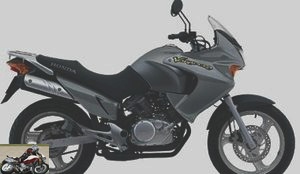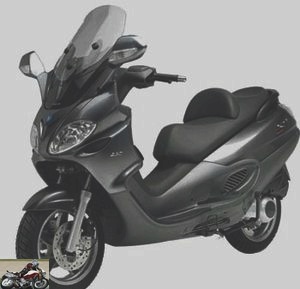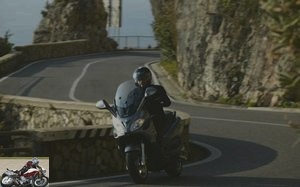Menus
- It is easy to be seduced by the "gross »Of a 125, turnkey price. But to be sure control your budget, you have to take into account the maintenance of the vehicle. For this, we looked at the cost total use of two popular flagship models, the Varadero 125 and the X9 125.
- The interview
- "Skip" a review: a very bad one idea
- In the end, insurance and gasoline make the difference
- Notes…
- Beware of hidden costs !
- Intervene yourself to reduce the bill
- Dealer-to-dealer differences
How much does a 125 actually cost ?
The X9 125 and the Varadero against the checkbook.
It is easy to be seduced by the "gross
»Of a 125, turnkey price. But to be sure
control your budget, you have to take into account the maintenance of the
vehicle. For this, we looked at the cost
total use of two popular flagship models,
the Varadero 125 and the X9 125.
 You are about to fall for a cute little 125,
You are about to fall for a cute little 125,
sold at an attractive price. However. The
revisions are to be made every 3,000 kilometers,
it swallows 5 liters per 100, its tires wear out faster than those of a car…
What seemed at first glance to be a good deal ends
by becoming a sinkhole after a few months. Something to make you regret
this other machine, sold a little more expensive, but whose
maintenance cost has nothing to do.
 To deal with this sensitive subject, since maintenance / consumption
To deal with this sensitive subject, since maintenance / consumption
is the 2nd budget item after the purchase of the motorcycle or
scooter, we chose to compare the usage budget over 3 years
of two models, the Varadero 125 and the Piaggio X9 125. We will take
assuming that these two vehicles will travel 24,000
kilometers in three years on a mixed road-city route, before
to be resold at the quotation. What to know what to expect
when we decide to buy.
The interview
To have a first estimate of what will cost
maintenance, it is essential to find out about the interval
from
revisions and their average cost. If the first
information is easy to obtain (all you have to do is consult the
maintenance), the second is more delicate. In addition to
variations in Paris / province tariffs, a concessionaire will be inclined to
the soft pedal on the announced price of revisions
so as not to frighten you. Anyway, it is – almost – obvious
than a 125 that goes through the workshop every 3,000 kilometers
will be more expensive to maintain than one who is content
one visit every 6,000.
There are four important positions to consider:
- the frequency of oil changes and the quantity / quality
of oil used, - tire wear and tire prices, fitted and balanced,
- transmission wear (chain or variator) and frequency
replacements, - various engine settings such as carburetor sync
or valve clearance (descaling / segmentation on 2 times).
According to the maintenance records of these two machines, the Varadero has
on paper an advantage: it is revised every 4,000 kilometers,
against all 3,000 for the X9 125. The “intermediate” revisions
»Are similar: it is a question of emptying the engine block, and
gaskets and oil filters. When it comes to "
big ”revisions, the Varadero still takes the advantage,
since the X9 must theoretically change the belt and possibly
the rollers of the variator every 6,000 km while the "big
»Servicing on the Varadero takes place every 12,000 kilometers,
with valve clearance, carburetor adjustment and change
of the air filter. To simplify the maintenance of your scooters,
Piaggio has decided to market a "kit"
comprising a transmission belt, rollers, a set of pads
front-rear and a candle, sold around 100 euros.
This initiative is a good point for machine users
Piaggio
: maintenance kits are much cheaper than separate purchase
of the parts that compose it.
On the tire side, the Varadero retains its advantage, since
its rear tire forfeits around 15,000
at 17,000 kilometers on average (provided you haven’t changed the original Pirelli Scorpion tires before), while that of the X9 will start
to be well worn only 10,000 km, wheel
small diameter requires. At the front, the gap is less marked
: 14,000 kilometers for the scooter, against 16,000 for the Varadero.
Information taken from Gommes, a rapid service specialist,
a set of tires mounted and balanced on a Varadero
costs 210 euros and 160 euros for the X9. To compare these two
results, seen the different lifetimes
envelopes, let’s assume that we are going to change at the same
time the front tire and the rear tire on each of the machines.
It is then easy to calculate the number of kilometers that
we can do for every euro spent. In the case
of the X9, we cover 62.5 km per euro, while the Varadero holds
71.4 kilometers (15,000
kilometers divided by 210 euros). This little calculation allows
to see that the Varadero is more economical
for use on the tire side.
|
X9 |
Varadero |
|||
|---|---|---|---|---|
|
Buying price |
4.300 € |
4.700 € |
||
|
Quantities |
Price |
Quantities |
Price |
|
|
Number of revisions (excluding revision of 1.000) |
8 |
500 € |
6 |
€ 380 (i.e. 7h30 of MO *) |
|
Consumption / 24,000 km (1) |
912 liters |
€ 1,186 |
1010 liters |
€ 1313 |
|
Liters of oil |
8 |
€ 80 |
10.5 liters |
105 € |
|
Number of front tires |
2 |
1 |
||
|
Number of rear tires |
2 |
1 |
||
|
Train prices |
€ 320 |
215 euros |
||
|
Number of AV platelets |
4 |
included in the kit |
2 |
38 euros |
|
Number of AR inserts |
4 |
included in the kit |
1 |
25 euros |
|
Number of candles |
4 |
included in the kit |
4 |
40 euros |
|
Chain kit (XLV) |
0 |
0 |
1 |
140 euros |
|
Various filters and gaskets |
included in the kit |
150 euros |
||
|
Repair kit (X9) |
4 |
€ 400 |
0 |
0 |
|
Paris third-party insurance (2) |
€ 586 |
€ 362 |
||
|
Third-party theft insurance Tours (3) |
€ 487 |
253 € |
||
|
Total maintenance and consumption |
€ 2,486 |
€ 2.406 |
||
|
Subtotal with purchase |
€ 6,786 |
€ 7.106 |
||
|
Resale (4) |
– 2.600 € |
– € 2,800 |
||
|
Total |
4.186 € |
€ 4.306 |
||
|
Cost per kilometer without insurance |
17.44 cts / km |
17.94 cts / km |
These figures have been rounded: no need to chase after
a few cents over 3 years of use
* with an hourly rate of 50 euros including all taxes.
(1) based on 3.8 liters per 100 for the X9 and 4.2 liters
at 100 for the Varadero, with a liter of Super 95 at 1.30 euros
(2) figures communicated by AMV for a driver without bonus
residing in Paris
(3) figures communicated by the Mutuelle des Motards for a driver
without bonus residing in Tours
(4) based on the Generation 125 rating
These figures still call for some comments. We
followed the manufacturer’s recommendations for the replacement
pieces. In practice, however, it is not uncommon to see
belts last 12,000 kilometers or spark plugs resume
their place because they are not damaged. Side
consumption and wear of parts, these are averages: a furious
of the throttle will pay much more than a calm user.
Likewise, we did not take into account the price of the drop. The elements
fairing of the Varadero or the pretty mirrors of the
X9s cost a fortune to replace. And there,
no question of turning to adaptable.
"Skip" a review: a very bad one
idea
Faced with the cost of maintaining their 125, some allow themselves
to "skip" a review. If the quality of
motor oils have actually surged in recent years,
the casings of the Varadero and the X9 only carry a small quantity.
Even if the oil consumption turned out to be far from
the warning rating, for example 0.1 liters per 1,000, travel 5,000 kilometers
without taking a look at the level would be suicidal. Once the oil sight glass
lit on the instrument panel, it is usually too
late. Neglecting your platelets is also a great way to shoot
a disc in record time: worn down to the sole,
the pads will attack the disc, requiring replacement.
A poorly tensioned chain without grease wears out quickly. Its breaking up, well
that rare, often results in damage to the engine block, not to mention
possible leg injuries. Finally, the belt
of the X9’s dimmer is one of its weak points. Neglect his
replacement every 6,000 kilometers is taking the risk
to see that of a
towing. Scooter owners have acquired from companies
operating tow trucks a reputation for good customers,
it’s not for nothing.
In the end, insurance and gasoline make the difference
In the end, we see for these two 125 a maintenance / consumption budget
almost comparable, within 100 euros. Piaggio made the effort
to market a maintenance kit that allows costs to be smoothed out
and it is he who makes the difference. Buy the parts
retail is quite ruinous, since the set of 3 plates
brake on its own is exchanged for around 80 euros.
Admittedly, the Varadero is revised every 4,000 kilometers
and its tires wear less quickly, but its chain kit and the small
"inexpensive" parts such as gaskets and
filters come to seal the bill. And thwart a favorable a-priori
to the motorcycle as to its maintenance cost in the face of
a scooter. However, the 400 euros difference to
the purchase end up being amortized by its maintenance cost
lower and a slightly higher resale price.
For the user, the arbitration will therefore be done on the gasoline budget,
since the X9 consumes on average almost half a liter less
at 100 than a Varadero (enviable when the price per liter soars to more than 1.30 €),
and especially on insurance. The fact remains that if the passage
per liter from € 1.05 / liter to € 1.30 / liter (and a fortiori € 1.50) amplifies the advantage for the
X9, the difference in cost per kilometer only drops from 0.3 to 0.50
cts euros (€ 0.003 to € 0.005).
On the other hand, at the insurance level, the 220 euros difference
in favor of the Varadero for similar guarantees hurts the
wallet, the fault mainly due to theft, in particular
on scooters. A gap that cannot compensate
fuel consumption.
Now remains to be taken into account
the practicalities of a scooter that bury any motorcycle
qualified
of "road".

Notes…
Beware of hidden costs !
Owners of chain drive motorcycles know it
good: it is necessary to lubricate the chain regularly,
at least every 500 kilometers, otherwise it will deteriorate
quickly. Especially if it rains often or you live nearby
from the sea. The price of the grease bombs is added to the replacement cost.
of the chain kit, inflating the addition of a few tens of euros.
The situation is paradoxical: if you often grease and clean your chain kit,
it will certainly last longer, but will be more expensive in maintenance
!
In the same vein, keeping a machine clean can end up coming back
expensive: shampoo, polish, product for plastics, oil for
cables and locks, scrubbing for the rims … we
quickly arrives at a hundred euros of supplies over three years
if one is meticulous or anxious to facilitate the resale of a
visibly pampered machine.
Finally, the price of the possible parking is also to be taken
into account. In the Paris region, it is not uncommon to have to
pay 50 euros per month to have a parking space
to protect your 125 from the rain … and from prying eyes. One can
thus spend more on parking than on insurance !
Intervene yourself to reduce the bill
On many machines, it is possible to make yourself
operations that do not necessarily require
go to dealers. With a little method, a few
adapted tools and the advice of a friend who really knows about it,
draining, changing a spark plug, or even creating a clearance in the valves is not
at all out of reach. For “intermediate” revisions
»Is a way to lower the bill: a seal, a filter,
2 liters of oil, and you save an hour of labor. TO
only do this if you are sure of what you are doing and after having
informed on the conditions of application of the manufacturer’s guarantees.
In the case of a "house" maintenance, we can turn to
to adaptable parts (pads, filters) sold less
expensive than by dealers. By buying your own oil,
we avoid endorsing this "trick" practiced
by some garage owners who charge for oil at retail
while they buy it in 100 liter drums at a
very advantageous price. Oil, in concessions, is a
little wine from restaurants.
Dealer-to-dealer differences
As we recall at Piaggio and Honda, the dealers are
free to practice the rates they want on labor and
the price of the parts. Manufacturers only communicate to them a
time scale and a recommended parts price.
Depending on the contract that binds it to the manufacturer (exclusive or not) and
of its sales volumes, a dealer will obtain more or less
discount on spare parts. Hence the
differences observed from one garage to another. It
You should still know that the margins on spare parts
where the consumables are very important, typically around
from 40 to 60%. It takes that to pay the mechanics.
Useful link: www.varadero125.fr
Related articles
-
Roadster or sports car? Which Aprilia V4 for the track ? A crazy V4 and very high-level electronic assistance, from € 14,849 So like that, Le Repaire…
-
Honda Varadero 1000 XLV motorcycle test
Maxi-Trail with a road vocation The Honda XL 1000 V Varadero, which appeared in 1998, is the heir to the famous Africa Twin … but the manufacturer has…
-
Comparo Piaggio MP3 LT 300 & 400
The cannibal family With the arrival of the MP3 300 LT, Piaggio is confusing a little the cards of its family of three-wheeled scooters. Especially since…
-
Comparo Harley-Davidson Street Glide 107 & Road Glide 107
Which model of the touring range to cut the road ? V2, 1745 cm3, around 90 hp, 150 Nm, from 376 kilos fully loaded, from 26,890 € Some manufacturers have…
-
Comparo Harley-Davidson Fat Boy Slim S
New life Recently unveiled, the 2016 Harley Davidson range is darker as desired by the Dark Custom program. A contemporary underground movement that the…
-
Comparo Boss Hoss Trike V8 & Harley-Davidson Tri Glide Ultra
A 1700 cc V2 at € 36,750 or a 5700 cc V8 at € 75,000 ? All the pleasures of motorcycling (or almost) … on three wheels Well, we will agree right away:…
-
Comparative test DN 01, XL700V Transalp ABS-CBS, NT700V Deauville ABS CBS What can lead to compare 3 motorcycles as different as a DN 01, an XL700V…
-
Comparo Harley-Davidson Sportster 1200 Forty-Eight Special & Iron
Two visions quite close to the cool and relaxed motorcycle V2, 1202 cm3, 66 hp, 98 Nm, 248 kilos, from 11,290 € One thousand nine hundred and…
-
Comparo Moto Guzzi Audacity and Eldorado
Moto d’Or: Audacity to conquer El Dorado After presenting its 1400 California in Aquira Nera version then Custom and finally Touring, Moto Guzzi…
-
Comparo Honda X-ADV / Africa Twin
Vendetta Sino-Corsica With two flagship models, Honda returns to adventure and versatility. Both the return of the legendary CRF1000L Africa Twin and the…